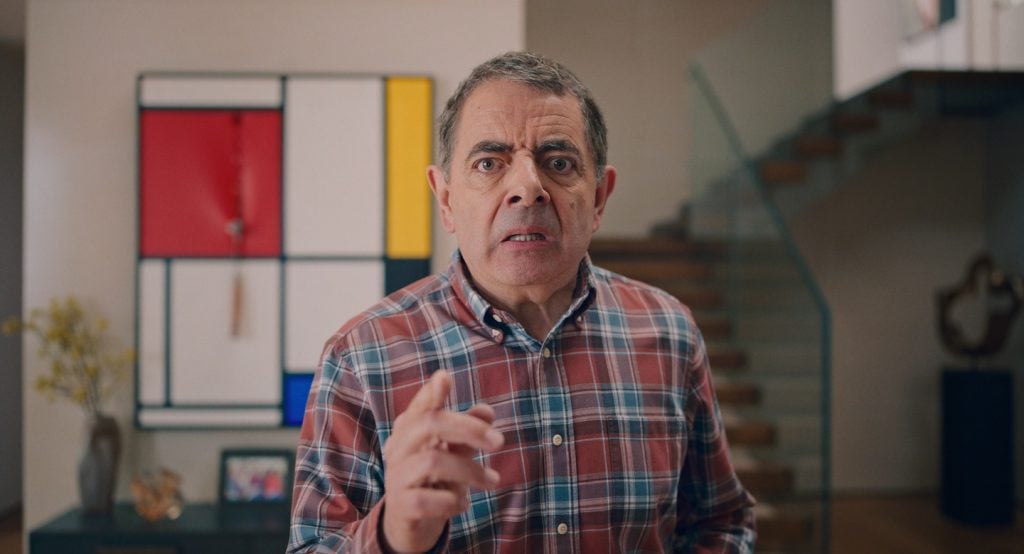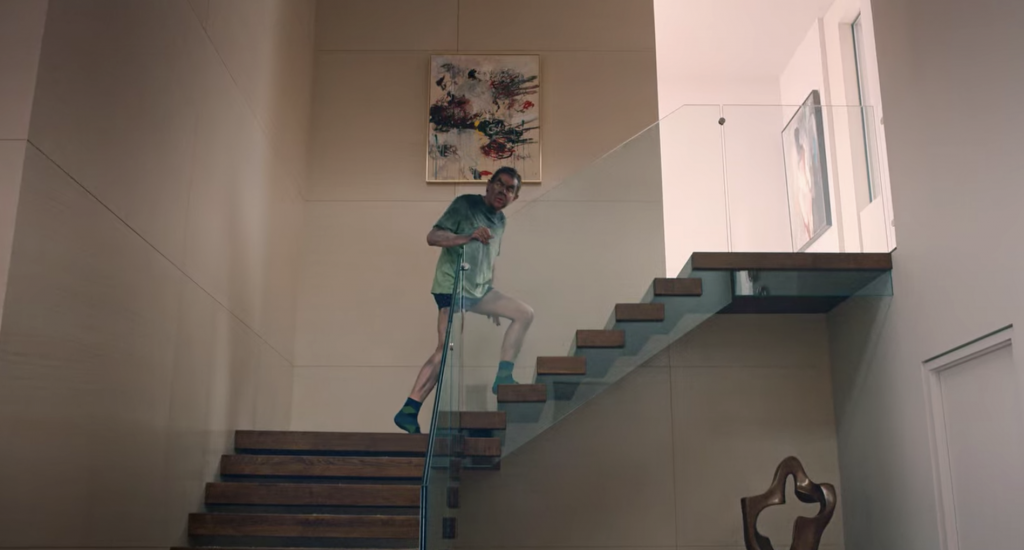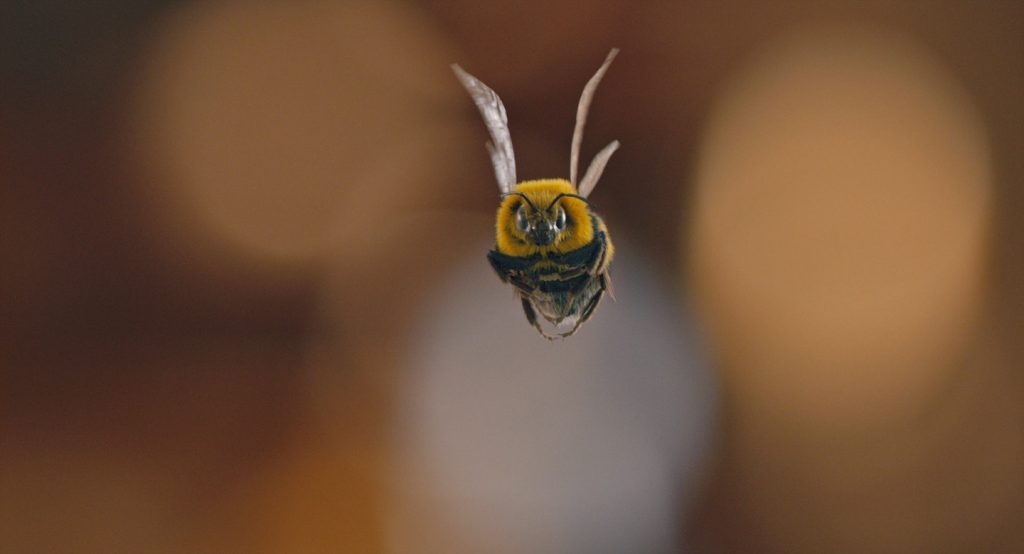Pop Culture
Actor Rowan Atkinson Destroys a Priceless Art Collection in Netflix’s ‘Man vs. Bee.’ The Showrunners Tell Us How They Made It Look So Real
Did you spot all of the artistic look-alikes in the series?

Did you spot all of the artistic look-alikes in the series?

Menachem Wecker

The original script for the 2022 comedy series Man vs. Bee, which stars co-creator Rowan Atkinson of Blackadder and Mr. Bean fame, called for the destruction of a work by Jackson Pollock. There’s really no way to talk about this nine-episode series without spoilers, but knowing that house-sitter Trevor (played by Atkinson)—doing his best impersonation of legendary physical comics Buster Keaton or Charlie Chaplin—inadvertently guts a priceless art collection while trying to kill a bee, does not diminish the joy of watching it in the least.
So why, when an errant hammer embeds itself in a canvas, does the painting look more like Broadway Boogie Woogie than Autumn Rhythm? It was tricky to secure cooperation from the Pollock-Krasner estate, which still owns the copyright for the late Abstract Expressionist’s work, said David Kerr, the show’s director. So Kerr suggested using a Mondrian, since the Dutch artist associated with De Stijl died in 1944, placing his work just inside the public domain.
“We made several copies of our prop painting, particularly due to the way its canvas is damaged by the hammer,” Kerr told Artnet News. With only four “Mondrian” reproductions to play with, created for the show by artist Humphrey Bangham, the scene could be shot a limited number of times. “You only have a few chances to capture the action perfectly,” Kerr said.
That was not the only recognizable copy of a famous artist’s work, however. Carly Reddin, the show’s production designer, thought the dozens of artistic recreations Bangham made for the show were all convincing. “It’s amazing how he can turn his hand to so many different styles,” she said. “Some people think they are the real deal and not fakes.”

A still from Man vs Bee. Photo: courtesy of Netflix.
The “Mondrian” worked out well in the end because—spoiler alert, again—it meant Trevor could repair the tear with black masking tape. That made the fix still resemble the original, “keeping its integrity,” Reddin said.
Throughout the nine episodes, which are now streaming on Netflix and mostly run about 12 minutes each (save for the 20-minute opener), Trevor ruins the entire collection of the rich couple for whom he is housesitting, as well as their home and very valuable cars.
At first, the producers sought a real, “boldly Modernist” house in which to film, one that would look like “a trophy home commissioned by a wealthy couple as the physical embodiment of their exquisite taste,” Kerr said.
The location manager scoured the country for something in the ballpark of architecture by Mies Van der Rohe and Frank Lloyd Wright, but the show needed a large house, both to underscore the wealth of owners Nina (Jing Lusi) and Christian (Julian Rhind-Tutt), and to provide adequate space for a large crew.
“The kind of physical comedy we were doing needed space and scale,” Kerr said. And although the script evolved, Kerr knew he needed some specific features for certain scenes: a glass wall leading out to the garden, a glass-paneled library, and a three-car garage.
Real locations turned out to be too small or inaccessible during the pandemic, so the filmmakers built a house interior in the studio, based on Reddin’s designs. One influence, Kerr said, was the Malibu mansion designed by Scott Mitchell, which appeared in Tom Ford’s 2016 film Nocturnal Animals.
The next task was dressing the sets, with an eye towards what they say about Nina’s and Christian’s characters, both of whom want to be seen as art and architecture connoisseurs. Some of the art collection the filmmakers created to communicate this is instantly recognizable, including paintings intended to be by Piet Mondrian and Ellsworth Kelly, and an object that could either be an ancient Cycladic head or a sculpture by Amadeo Modigliani.

A still from Man vs Bee. Photo: courtesy of Netflix.
Others are tougher to peg. An outdoor sculpture looks like it could be the work of Constantin Brâncuși or Henry Moore; a kind-of Cy Twombly hangs on a wall; and an apparent Alexander Calder mobile is actually a piece by Wassily Kandinsky. “I paid £80,000 for that,” Christian tells Trevor at one point in the series. “It turned out to be a Kandinsky. It’s worth a lot of money.”
As with the Pollock-turned-Mondrian, permissions guided that cinematic decision. The mobile was originally meant to be a Calder, but “once again, copyright was an issue,” Kerr said. So it became a Kandinsky, and the designers worked backwards to determine its form from the function they needed for the filming. So elements of the piece resemble domestic items, like a yellow marmite lid, which Trevor uses to repair it.
Above the aesthetic considerations, each piece is a blue-chip item. “Christian always circles back to the monetary value of any item—and likes to tell people how shrewd his investments have been,” Kerr said. “Unlike some art collectors, who focus on one specific artist, style, or period, Christian’s collection is eclectic—spanning medieval manuscripts and Modernism.”
An illuminated manuscript (“worth millions,” again per Christian) seems like an Ethiopian bible, and other works evoke 17th-century Dutch pictures (maybe Frans Hals?), and there is perhaps a James Ensor. Quite a few abstract works echo Stuart Davis or others.

Production still from Man vs Bee. Photo: courtesy of Netflix.
Christian identifies an obvious Degas look-alike as a Sickert—though the picture looks nothing like a work by Walter Sickert—and tells a guest he bought it for £300,000, suspecting it was a Degas, and had it insured at £15 million (values are not converted to dollars since they are imaginary).
The whole collection yields £4 million in insurance money—sorry, spoiler again—which seems a bit low, while the house’s general damage from a fire Trevor unleashes at the end rings up £3 million. Another £2 million for a wrecked Jaguar rounds out the payment to £9 million.
Other design decisions were made based on the logistics of comedy. A statuette that—spoilers again—Trevor decapitates, and upon which the collectors’ dog Cupcake munches, was originally one of two dismembered ancient sculptures.
But a Greek figure with a phallus that is knocked off felt too similar to the one which loses its head, so it was ditched for the “Modigliani.” The latter, inspired by the Italian artist’s sculptures but not a direct copy, required “a head that would roll amusingly from side to side when it fell on the floor—and was the right size to fit in our dog’s mouth,” Kerr said.

Production still from Man vs Bee. Photo: Ana Cristina Blumenkron/Netflix, © 2022.
“It took a long time for us to settle on the final design for the ‘Modigliani’ statue, deciding whether it should represent a female or male, how big should the belly be, how wide should the legs be, etc.,” Reddin said. The head had to be big enough for Cupcake to carry off, but small enough that the sculpture would stand up. The prop was made from something like a sponge, according to Reddin.
“We sent a prototype to Cupcake’s owners, so they could practice the action,” she said. “Similarly, we made prototypes of the library manuscript, so Cupcake could practice tearing it up.”
That illuminated manuscript, which Cupcake mutilates, contains copies of pages from real manuscripts, including one with a self-referential beehive image, according to Kerr. “We tested the prop pages to make sure they were of a weight that the dog could manage to mangle with his paws and mouth,” he said.
That outdoor sculpture previously mentioned was actually inspired by Moore and by Barbara Hepworth, according to Kerr. And it was placed with a hinge on its pedestal to facilitate teetering and falling on the E-type Jaguar—another spoiler, sorry.
So what was it like for the show’s creators to see such realistic takes on important artworks suffer so much abuse? Neither Kerr nor Reddin seemed fazed.
The “art” had to look realistic enough that the audience would suspend disbelief and invest in the “jeopardy surrounding their potential destruction,” Kerr said. “But as a director, I didn’t feel precious towards them. They were very simply props. My concern was to make sure they could be damaged in the very specific way that would best support the comedy.”

Production still from Man vs Bee. Photo: courtesy of Netflix.
The destroyed “art”—and a final spoiler here: those quotation marks are doubly significant—did not affect Reddin at all, since she knew their ultimate fate.
“It was very important that the props and paintings looked expensive and were part of an extensive art collection to fully invest in the story,” she said, “but these artifacts were made inexpensively, and so it didn’t pain me when they were destroyed.”
In the end, the whole set was burned. “I think the paintings and props got off lightly!” Reddin said.